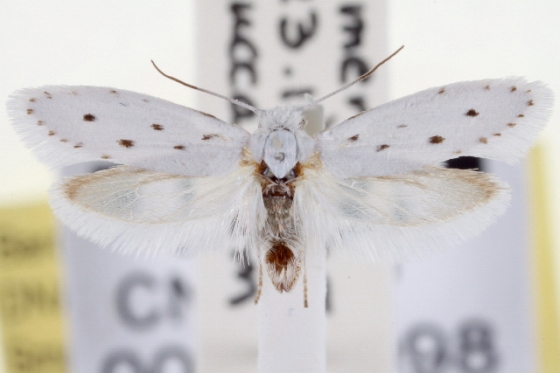The Five-spotted Bogus Yucca Moth, Prodoxus quinquepunctellus
By Isaac MacLean

Mark J. Dreiling via bugguide.net (2) CC BY-ND-NC 1.0
The Five-spotted Bogus Yucca Moth (Prodoxus quinquepunctellus) belongs to the family Prodoxidae of the Lepidoptera (moths and butterflies). It is a small, nondescript, almost entirely white moth with a few small dark spots on its forewings. Although it can be found in much of the United States, there is only one remaining population in Canada1. This species’ SARA (Species at Risk Act) status is endangered1. An endangered species is one that is very close to being extinct or extirpated. In the case of the Five-spotted Bogus Yucca Moth, it is very close to being extirpated from Canada1 (which means that the species is nearly gone in Canada, but still exists in other locations).
In order to understand where the Five-spotted Bogus Yucca Moth got its odd-sounding name, you need a little background on another moth and the plant it relies on. In Canada, Yucca is found only in Alberta1. It is a small shrub pollinated exclusively by the Yucca moth (not the “bogus” Yucca moth)1. Why do the Yucca moths pollinate Yucca plants? When a Yucca moth lays its eggs on a Yucca, they develop into larvae, and the larvae need something to feed on. The Yucca moth is the only pollinator of Yucca, and as a sort of “thank you” for pollination, some of the seeds a Yucca produces feed the developing moth larvae6.
So where do the Bogus Yucca Moths (genus Prodoxus) come into all of this? They got their “bogus” name because although they also need Yucca for their larvae to survive, they do not aid in pollination and their larvae do not feed on Yucca seeds.6 A female Bogus Yucca Moth will lay its eggs inside the flowering stalk of the Yucca plant. When the larvae emerge, they feed on the stem tissue of the Yucca1.

BIO Photography Group/CNC, Biodiversity Institute of Ontario via Boldsystems.org (3)
The Five-spotted Bogus Yucca Moth is so fragile because of its complete reliance on Yucca and Yucca Moths. If a Yucca Moth does not pollinate a Yucca’s flowers, no fruit is produced and the flowering stalk withers1. Almost all larvae within a flowering stalk that bears no fruit will be killed when it withers1. This species has been listed on SARA because in Alberta, there are only two populations of Yucca, and only one of them currently supports a population of Five-spotted Bogus Yucca Moths1. There are only an estimated 500 to several thousand Five-spotted Bogus Yucca Moths remaining in Canada1.
To keep this species from becoming extirpated from Canada, we must protect it and the species it relies on. Because of the relationship the Five-spotted Bogus Yucca Moth has with both Yucca moths and Yucca, any threat to the latter two will be an equal threat to the Five-spotted Bogus Yucca Moth. Currently, threats to Yucca and Yucca moth populations include cold weather, consumption by mule deer and pronghorn antelope, off-roading vehicles, and collection of the plant for medicinal use1,5.
Some possible actions that could be taken to minimize these threats are already being implemented through SARA and were outlined in the 2011 SARA recovery strategy for Yucca and Yucca moths. These include plans for habitat protection by limiting public access, fencing to deter mule deer and antelope, and a museum display to promote Yucca conservation6. Further action to protect the species could be implementing regulations on the collection of Yucca for medicine or horticulture. It is important to spread information about the conservation of the Five-spotted Bogus Yucca Moth, its host plant, and the Yucca moth as without public knowledge of threats to them and their habitat the risk of extirpation from Canada greatly increases.
References
- https://www.registrelep-sararegistry.gc.ca/species/speciesDetails_e.cfm?sid=927#ot18
- http://bugguide.net/node/view/631427/bgpage
- http://www.boldsystems.org/index.php/Taxbrowser_Taxonpage?taxid=139786
- http://www.registrelep-sararegistry.gc.ca/species/speciesDetails_e.cfm?sid=715
- Snell RS and Addicott JF. 2008. Limiting the success of stem borers (prodoxus quinquepunctellus) in yuccas: Indirect effects of ants, aphids, and fruit position. Ecol Entomol 33(1):119-26.
- http://www.registrelep-sararegistry.gc.ca/virtual_sara/files/plans/rs_soapweed_yucca_moth_0811_eng.pdf
[…] The five-spotted bogus yucca moth, by Isaac MacLean […]
[…] spotted. Five-spotted bogus yucca moth, perfectly profiled by Isaac […]